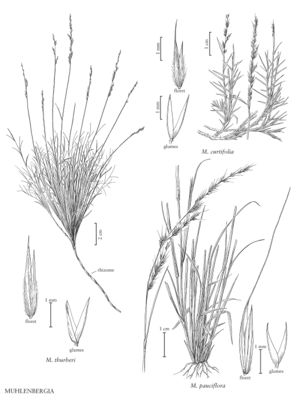Muhlenbergia curtifolia
Plants perennial; rhizomatous, not cespitose. Culms 10-45 cm tall, 0.3-0.5 mm thick, erect or decumbent; internodes hirsute and strigose below the nodes. Sheaths shorter than the internodes, hirsute; ligules 0.2-0.6 mm, margins hyaline, apices truncate to obtuse, erose, ciliate; blades 0.5-4(5) cm long, 0.6-1.5(2.2) mm wide, awl-shaped, flat near the base, becoming slightly involute distally, strigose to scabrous abaxially, hirsute adaxially. Panicles 2-10 cm long, 0.2-1 cm wide, contracted, not dense; primary branches 0.3-2.5 cm, ascending to appressed; pedicels 0.1-3 mm. Spikelets 2.8-4 mm. Glumes equal, 2.5-4 mm, 1-veined, veins scabridulous, apices acute; lemmas 2.8-4 mm, lanceolate, hairy on the lower 3/4, hairs to 1.5 mm, tawny, midveins scabridulous distally, apices acuminate, awned, awns usually 1-6(12) mm, delicate, straight; paleas 2.8-4 mm, lanceolate, intercostal region tawny pubescent on the basal 3/4; anthers 1.2-1.6 mm, yellowish-purple. Caryopses 2-2.4 mm, fusiform, brownish. 2n = unknown.
Distribution
Utah, Ariz., Nev.
Discussion
Muhlenbergia curtifolia grows on damp ledges and in rock crevices of vertical cliffs, and beneath large calcareous boulders above the canyon floor, at elevations of 1600-2750 m, in the southwestern United States. It resembles M. thurberi, differing in its flatter leaf blades and shorter ligules and anthers. It also tends to grow in more mesic habitats than M. thurberi.
Selected References
None.
